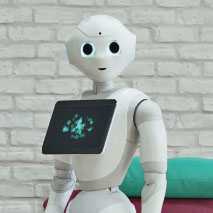Cruise company Costa Crociere has taken five robots on-board to entertain its passengers. They not only provide the guests with up-to-date information, but are also able to detect how they are currently feeling.
On the Costa Diadema, the flagship of the Costa Crociere line, guests are now welcomed on-board and provided with assistance by five “Pepper” model robots. The Pepper is the world’s first robot capable of read human emotions and needs, and interacting proactively with people.
“Ahoy” in English, French and Italian
The robots developed by Softbank Robotics operate on the Costa Diadema’s seven-day cruises around the western Mediterranean. Their mission: to entertain the guests on-board, and make the cruise even more unforgettable than it would otherwise be. The robot was first launched in Tokyo in 2014. It incorporates lots of innovative features, and has high-level communication skills. It is able to converse faultlessly in English, French and Italian, and can recognise voices and faces. “By our deployment of emotionally interactive robots on-board our cruise ships, we have once again demonstrated our great innovative capability. For us this is a major step towards the digital future of our cruise brands. I am certain our guests will love Pepper,” comments Michael Thamm, CEO of the Costa group.
Recognising human emotions
Pepper is the first humanoid robot in the world capable of recognising the key human emotions: joy, sadness, anger or surprise. It can also smile, furrow its brow, as well as interpreting the tone of a voice. Pepper is also able to interpret the words a person uses, as well as non-verbal signs such as a nod of the head. By combining all this information, the robot can determine whether its human counterpart is in a good or bad mood. The robot’s 2D and 3D cameras enable it to find its way around, and object recognition software allows it to recognise faces and objects. A wide range of other sensors complement the camera systems, including ones to measure distances to obstacles for example. Among these are two ultrasonic and six laser sensors, as well as three obstacle detectors in the little robot’s legs. Pepper also has tactile sensors in its hands which it uses when playing games or interacting socially.
Entertaining and informing
The guests on-board the Costa Diadema encounter the robots in various areas of the ship. Pepper is not only able to answer questions put to it, but can also interact proactively as soon as a passenger approaches. Pepper dances and plays with guests, and poses for selfies with them. The robots are designed not only to make the guests smile, however, but also to provide them with useful information about their journey and the amenities available on-board. The robots know everything about the ship’s restaurants, bars and shops, and can give details of shore excursions and on-board activities. They can also provide information on upcoming destinations and the ship’s route. And Pepper also asks the passengers on the Costa Diadema what they think about the cruise and the on-board amenities.
Anyone who visits EBV Elektronik’s stand at optoelectronic trade fairs can experience Pepper in action; giving presentations and joking around with visitors. Sebastian Hülck, Director Segment Lighting at EBV, talks about his experience with Pepper.
How long have you been using Pepper?
Sebastian Hülck: We rolled him out for the first time at the LED Professional Symposium 2016 in Bregenz, Austria. I believe we were the first ones to have used Pepper at a European trade fair.
How difficult is it to adapt Pepper for your own applications?
S. H.: It does take a great deal of effort, that much is true. The firm NoDNA in Ismaning took care of that for us: they are one of the authorised dealers for Softbank Robotics/Aldebaran. It took around three months to get Pepper up to his current standard – and to equip him with the various gimmicks which he has mastered to date.
So Pepper can’t be programmed quickly using an app?
S. H.: No. There are specific development environments for Pepper which you have to get to grips with first, such as the Choreographe Suite. In addition to that, the robot is a very complex piece of kit – with his eight-core Intel Atom platform, 20 motors and array of sensor systems. As an operating system, the machine runs the Linux-based Qi OS.
Does Pepper actually recognise human emotions?
S. H.: If you interact with him on a one-to-one basis, that actually works pretty well. On the other hand, he is overwhelmed when surrounded by lots of people. In that scenario, he doesn’t recognise individual people and no longer listens to one specific person. What’s more, the speech engine could still be optimised further. Amazon Echo or voice recognition systems from Apple or Google work much better, in fact.
How do people react to Pepper?
S. H.: The robot makes a fantastic impression on visitors. At the trade fair in Bregenz, our gimmicks made Pepper a real crowd-pleaser. Anyone who is interested in doing so is more than welcome to experience our robot for themselves: either at the trade fairs we attend with our Lighting Segment or in our “LightSpeed Experience Center” in Poing, Germany. Here, we demonstrate future technology related to optoelectronics. With his six lidar sensors, Pepper fits into this environment perfectly – that includes our focus on retail solutions this year.



